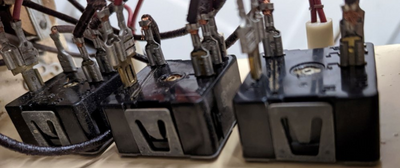The Science of Heat Treatment in a Kiln: Exploring Methods and Benefits

What Exactly is Heat Treatment?
Heat treatment is the process of heating and cooling a material in order to change its physical and mechanical characteristics while maintaining its form.
In this post, we'll take a top-line look at the various types of heat treatment, the tools of the trade, and the benefits they provide.
Heat treatment is critical in production because it improves material mechanical qualities such as strength, toughness, ductility, and wear resistance. It also enhances corrosion resistance and minimizes internal tension, making the material more robust and trustworthy. Heat treatment also makes it easier to shape materials into diverse shapes, such as castings, forgings, and extrusions, allowing them to fulfill design standards. This is typically done in a kiln, oven, or furnace with digitally controlled temperature monitoring.
Heat processing may be used on a wide range of materials such as metals, alloys, ceramics, glass, and polymers. * Gears, shafts, springs, and bearings in the manufacturing industry * Turbine blades, exhaust nozzles, and landing gear in the aerospace industry * Engine parts, brake discs, and suspension parts in the automotive industry * Surgical instruments and implants in the medical industry. for a more in-depth look at heat treating you'll want to check out the book, Practical Heat Treating: Basic Principles, by Jon L. Dossett
Industrial ovens, kilns, and commercial furnaces are critical heat treatment instruments. They offer a regulated heating environment that enables constant and exact temperature control, guaranteeing that materials are heat treated in accordance with particular design specifications. They can be fueled by either electricity or gas and come in a variety of configurations that can be customized for any application.
Industrial ovens, kilns, and furnaces are used in a variety of sectors, including the energy, electronics, and chemical industries, for curing and drying operations. In the ceramics industry, kilns are used to heat materials to high temperatures, resulting in stronger and more lasting final products. Metal heat treatment required tightly controlled temperatures for accurate and consistent heating and cooling.
What Are Some of the Different Heat Treating Methods?
There are multiple heat treatment procedures, including annealing, tempering, quenching, and normalizing.
Annealing - Annealing is a heat treatment process that involves heating a material to a high temperature and then slowly cooling it down. This process helps to improve the material's ductility and reduce its hardness. Think of a spring and the way it needs to bend and not break without being brittle. Annealing is commonly used in the production of steel and other metals.
Tempering - Tempering is a heat treatment process that involves heating a material to a high temperature and then rapidly cooling it down. This process helps to improve the material's toughness and reduce its brittleness. Think of a hammer that needs to be struck multiple times without chipping or splitting or loosing it's shape. Tempering is commonly used in the production of tools and other high-strength materials.
Quenching - Quenching is a heat treatment process that involves heating a material to a high temperature and then rapidly cooling it down by immersing it in a quenching medium, such as water or oil. This process helps to improve the material's hardness and strength. Think of the above mentioned hammer or spring, this process gives them their hardness. Quenching is commonly used in the production of gears, springs, and other high-stress components.
Normalizing - Normalizing is a heat treatment process that involves heating a material to a high temperature and then allowing it to cool in still air. This process helps to improve the material's uniformity and reduce its internal stress, thus eliminating cracking and weakness in joints over time. Normalizing is commonly used in the production of castings and forgings.

The Advantages of Heat Treating
Heat treatment has a number of advantages, including increased strength, hardness, toughness, ductility, and wear resistance. It can also increase corrosion resistance and minimize internal tension in the material.
These are just the basic few definitions, and there are so many more sub-definitions and categories once you dive deeper. Our friends over at Thomas.Net have a really great list you might want to check out. We think it's a pretty comprehensive glossary!
Finally, heat treatment is a fundamental procedure that is essential in the manufacture of a range of materials. Understanding the various heat treatment processes and their benefits is a must for producers and kiln operators in making educated judgments about which procedure to utilize for a specific material. Manufacturers will increase the performance and durability of their goods by using the proper heat treatment method, making their products stronger contenders in the market.
Want to learn more? You can take an e-course from the American Foundry Society for a really affordable price! In their e-Learning module, steel heat treatments will be defined and the basic steps to heat treating steel will be identified. The following heat treatment techniques will be introduced: annealing, normalizing, quenching, tempering, austempering, precipitation hardening, solution treating, and stress relieving. You'll even get some continuing education credits!
Contact us today to find out how we can help you improve your heat treatment process and obtain the best outcomes possible.
As always, feel free to reach out to our experienced team with questions or comments. We're always here to help! Give our technical team a call at (210) 446-9979 or email us at customerservice@heattreatnow.com




